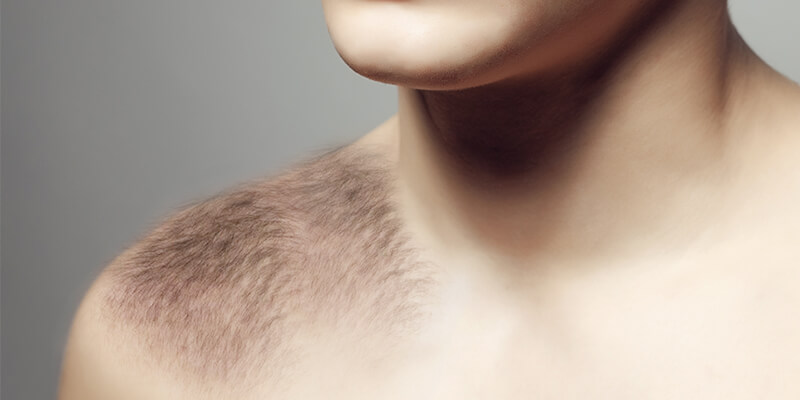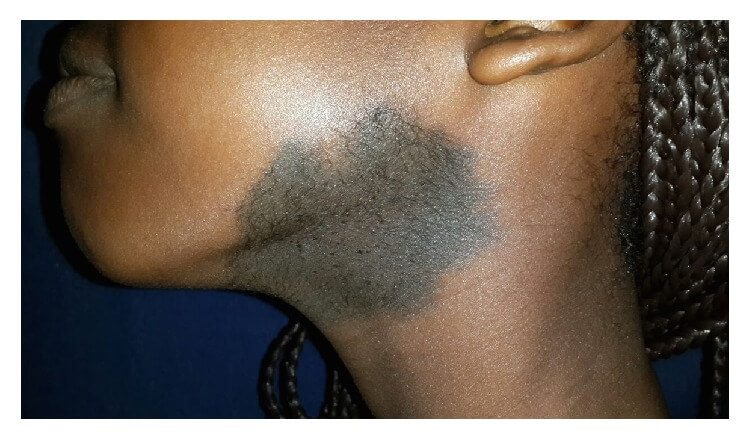Becker's Nevus
Clinical Definition and Features
 Figure X-1: Becker's nevus in a male patient | Photo courtesy of OLIVA Skin & Hair Clinic Opens in new window
Figure X-1: Becker's nevus in a male patient | Photo courtesy of OLIVA Skin & Hair Clinic Opens in new windowBecker’s nevus is a benign acquired hamartomatous condition of the epidermis and hair follicles associated with hyperpigmented, and often hypertrichotic macule or slightly elevated patch measuring several centimeters in diameter.
Although Becker’s nevus characteristically shows a predilection for the chest, shoulder and upper arm, it may also occur on other regions of the body and have been described on the scalp, forehead, cheeks, eyelids, neck, abdomen, hips, lower legs, buttocks, and hand.
Becker’s nevus is androgen dependent. Patients present with a gradually enlarging, unilateral, pigmented macular lesion. After developent, the macular lesion enlarges gradually for a year or two but then remains stable in size.
The lesions mostly occur in late adolescence or early adulthood with the same frequency in males and females.
 Figure X-1: Becker's nevus in a female patient | Photo courtesy of Europe PMC Opens in new window
Figure X-1: Becker's nevus in a female patient | Photo courtesy of Europe PMC Opens in new windowPatients subsequently develop hypertrichosis Opens in new window, a condition characterized by the growth of hair in an excessive amount. However, the Becker’s nevus in females fails to show the increased hairiness characteristic of Becker’s nevus in males.
Becker’s nevus ranges in size from a few centimeters in diameter to palm size or larger. There may be slow centrifugal extension of pigmentation.
Hyperpigmentation varies from uniformly tan to dark brown, well demarcated lesions, but the margins are usually irregular and islands of pigment may be present in the surrounding skin—a description that has been compared to an archipelago Opens in new window.
The center of the lesion may show slight thickening and corrugation of the skin. The color is stable or may darken with sun exposure. Hairiness usually develops after pigmentation, and the hairs become coarser and darker with time.
The hypertrichosis and pigmentation may not overlap completely. Sometimes hypertrichosis Opens in new window is subtle and can only be appreciated by comparison to the contralateral side. As previous mentioned, hypertrichosis is absent in Becker’s nevus occurring in women.
The pigmentation and hair distribution are highly variable, and subtle lesions may be difficult to distinguish from café-au-lait macules Opens in new window.
Although it is usually acquired, very occasionally the lesion is present at birth or develops in the first few years of life, and rare familial cases have been documented.
Table X-1 summarily highlights the clinical features of Becker’s nevus
| Clinical Features of Becker Nevus |
|---|
|
Occasional developmental abnormalities have been found associated with Becker’s nevus (termed the Becker’s nevus syndrome) and are generally hypoplastic in nature.
These abnormalities include hypoplasia of the ipsilateral breast, areola, nipple, arm, ipsilateral arm shortening, lumbar spina bifida, thoracic scoliosis, and pectus carinatum, as well as enlargement of the ipsilateral foot.
Rarely Becker’s nevus may be associated with a connective tissue nevus or an underlying desmoids tumor.
Pathogenesis
Becker’s nevus is an organoid nevus Opens in new window of ectodermally and mesodermally derived tissues, and a segmental increase in androgen receptors and probable heightened sensitivity to androgens have been postulated.
The latter characteristics would explain its onset during or after puberty leading to its clinical and histologic manifestations, which include hirsutism, acanthosis, dermal thickening, acne, and hypertrophic sebaceous glands.
Androgen Opens in new window stimulation would also explain the accentuated smooth muscle elements often found in the dermis of Becker’s nevus patients. Hyperpigmentation Opens in new window is due to increased melanin content in the epidermal keratinocytes and is often preceded by extensive sun exposure that has resulted in sunburns.
Differential Diagnosis
The principal entities to be considered in the histologic differential diagnosis of Becker’s nevus include café-au-lait macule, lentigo simplex, epidermal nevus, and congenital melanocytic nevus.
Therapeutics
Patients should be reassured that the lesion of Becker’s nevus is benign and no treatment is necessary, as the risk for malignant degeneration is extremely low.
However, with insistent patients, the hyperpigmentation Opens in new window and hypertrichosis Opens in new window can be treated with laser therapy for cosmetic or psychosocial reasons.
Treatments for hyperpigmentation
- Er:YAG laser
- Q-switched ruby laser
- Frequency-doubled QSNd:YAG laser
Treatment of hypertrichosis
- Ruby laser (normal mode)
- Electrolysis
- Depilatories
See also:
- Burgreen BL, Ackerman AB (1978) Acneiform lesions in Becker’s nevus. Cutis 21:617-619.
- Tymen R, Forrestier JF, Bontet B, Colomb B (1981) Nevus Tardif de Becker. Ann Dermatol Venereol 108:41-46.
- Copeman PM, Wilson JE (1965) Pigmented hairy epidermal nevus (Becker). Arch Dermatol 92:249-251.
- Sood A, D’Souza P, Verma KK. Becker’s nevus occurring at birth and in early childhood. Acta Dermatol Venereol 1998;78:311.
- Trelles MA, Allones I, Velez M, et al. Becker’s nevus: Erbium:YAG versus Q-switched neodimium:YAG? Lasers Surg Med. 2004;34(4):295-297.
- Angelo C, Grosso MG, Stella P, et al. Becker’s nevus syndrome. Cutis 2001;68:123-124.
- Cox NH. Becker’s nevus of the thigh with lipoatrophy: a report of two cases. Clin Exp Dermatol 2002;27:27-28.
- Rasi A, Taghizadeh A, Yaghmaii B, et al. Becker’s nevus with ipsilateral breast hypoplasia: a case report and review of the literature. Arch Iran Med 2006;9:68-71.

